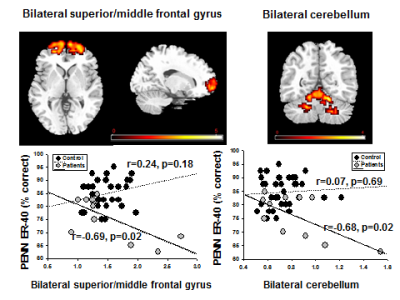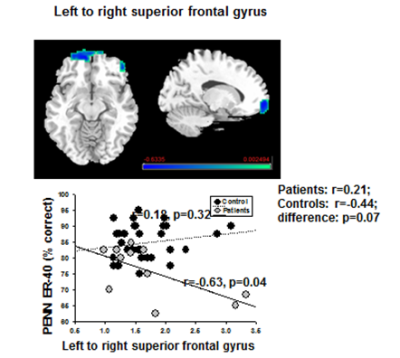1842
Peripheral oxytocin and vasopressin modulates regional brain activity differently in men and women with schizophrenia1Radiology, West China Hospital, Sichuan University, Chengdu, China, 2Psychiatry, Women's Mental Health Research Program,University of Illinois at Chicago, Chicago, IL, United States
Synopsis
Oxytocin (OT) and arginine vasopressin (AVP) exert sexually dimorphic effects on cognition and emotion processing in healthy individuals, and abnormalities in these neuroendocrine systems are observed in schizophrenia with a sex-dependent manner. Here we examined sex-dependent hormone associations with resting brain activity by applying resting-fMRI and their clinical associations in schizophrenia patients relative to healthy controls. We found that hormones differentially associate with brain networks, the sex-dependent alternation of hormone and brain activity are important for cognition and emotion processing in men and women with schizophrenia.
INTRODUCTION
Oxytocin (OT) and arginine vasopressin (AVP) exert sexually dimorphic effects on cognition and emotion processing in healthy individuals. Abnormalities in these neuroendocrine systems are observed in schizophrenia and may contribute to deficits in cognition and emotion processing a sex-dependent manner. 1, 2Here we examined sex-dependent hormone associations with resting brain activity and their clinical associations in schizophrenia patients relative to healthy controls.METHODS
OT and AVP serum concentrations were assayed in 35 individuals with schizophrenia (12 women, 23 men) and 60 healthy individuals (36 women, 24 men) from the study. Regional cerebral function was assessed with resting state fMRI by measuring the amplitude of low-frequency fluctuations (ALFF) which are believed to reflect spontaneous neuronal activity during rest. Participants underwent 5 minutes of scanning using a GE Signa EXCITE 3.0 Tesla MR imaging system and an 8-channel phased array head coil. The Brief Assessment of Cognition in Schizophrenia (BACS) neuropsychological test including three subtests (verbal learning, verbal fluency and semantic fluency) and the Penn Emotion Recognition (ER)-40 Test assessed the ability to accurately recognize facial emotions were collected. The image data was preprocessed by Data Processing Asisstant for Resting-State fMRI, version 2.3(http://rfmri.org/DPARSF) software. The statistical analytic processes were applied in REST software (Resting-State fMRI Data Analysis Toolkit V1.8; http://restfmri.net/forum/rest).RESULTS
AVP but not OT levels were lower in schizophrenia versus controls (p=0.01). In women,higher OT levels were associated with higher ALFF in frontal and cerebellar cortices in patients(p’s<0.05) versus controls. Higher AVP levels were also associated with lower ALFF in the superior temporal gyrus, anterior cingulate, and cerebellar cortex in patients (p’s<0.05) versus controls. In men, higher OT levels were associated with higher ALFF in the posterior cingulate and higher AVP levels were associated with higher ALFF in the frontal cortex in patients (p’s<0.05) versus controls. Furthermore, higher OT levels were associated with higher ALFF in the frontal cortex and lower ALFF in the thalamus in controls (p’s<0.05) versus patients. In female patients, higher ALFF in frontal and cerebellar cortices were associated with poorer facial emotion recognition and higher ALFF in the frontal cortex was associated with poorer verbal fluency (p’s<0.05). In male patients, higher ALFF in the thalamus was associated with poorer emotion recognition, verbal learning, and processing speed in male patients (p’s<0.05), and higher ALFF in the frontal cortex was associated with poorer verbal fluency (p<0.05) (Figure 1-4).DISCUSSION
The correlations between hormones and ALFF indicated the difference caused by sex and illness. OT and AVP may function differently by active regions above in men and women. Higher levels of OT were generally associated with increased activity across the brain both for male and female patients, indicates that OT may function by elevating activity of regions in both sex; In female patients, higher ALFF in frontal and cerebellar cortices were associated with poorer facial emotion recognition, it may in part explain the mechanism for its impact on functional activity and the capacity of OT to dampen emotion reactivity. Previous study has suggested that OT is directly related to brain function and behavior, possibly via the autonomic nervous system, which regulates emotion and state. 3In male patients, higher ALFF in the posterior cingulate was associated with poorer verbal fluency, it could be affected by the illness duration of schizophrenia with cognitive decline, and it may occupy the same important part with the effect of OT.4, 5
AVP associations vary in male and female patients, where higher AVP associated with reductions of activity in female patients and increased activity in male patients. It is consistent with the facts that sex-specific associations between AVP levels and neural activity during the emotion test, these findings may suggest that female patients are more sensitive to AVP than male patients. 6The poor emotion and cognition reaction appeared in both male and female with different brain regions, one possibility for the findings is that AVP, may modulate activity in frontal and cerebellar cortex and thereby influence emotional reactivity and activity in related regions.7
CONCLUSION
Hormones differentially associate with brain networks important for cognition and emotion processing in men and women with schizophrenia. Associations with frontal and cerebellarcortices in female patients and the posterior cingulate in male patients may play sexually dimorphic roles in emotion processing and cognitive deficits in schizophrenia.Acknowledgements
No acknowledgement found.References
1. Carter CS, Grippo AJ, Pournajafi-Nazarloo H, Ruscio MG, Porges SW. Oxytocin, vasopressin and sociality. Progress in brain research 2008; 170: 331-6.
2. Carter CS, Pournajafi-Nazarloo H, Kramer KM, et al. Oxytocin: behavioral associations and potential as a salivary biomarker. Annals of the New York Academy of Sciences 2007; 1098: 312-22.
3. Gimpl G, Fahrenholz F. The oxytocin receptor system: structure, function, and regulation. Physiological reviews 2001; 81(2): 629-83.
4. Hill SK, Reilly JL, Keefe RS, et al. Neuropsychological impairments in schizophrenia and psychotic bipolar disorder: findings from the Bipolar-Schizophrenia Network on Intermediate Phenotypes (B-SNIP) study. Am J Psychiatry 2013; 170(11): 1275-84.
5. Feifel D, Macdonald K, Cobb P, Minassian A. Adjunctive intranasal oxytocin improves verbal memory in people with schizophrenia. Schizophr Res 2012; 139(1-3): 207-10.
6. Rubin LH, Yao L, Keedy SK, et al. Sex differences in associations of arginine vasopressin and oxytocin with resting-state functional brain connectivity. Journal of neuroscience research 2017; 95(1-2): 576-86.
7. Tomasino B, Gremese M. Effects of Stimulus Type and Strategy on Mental Rotation Network: An Activation Likelihood Estimation Meta-Analysis. Frontiers in human neuroscience 2015; 9: 693.
Figures



